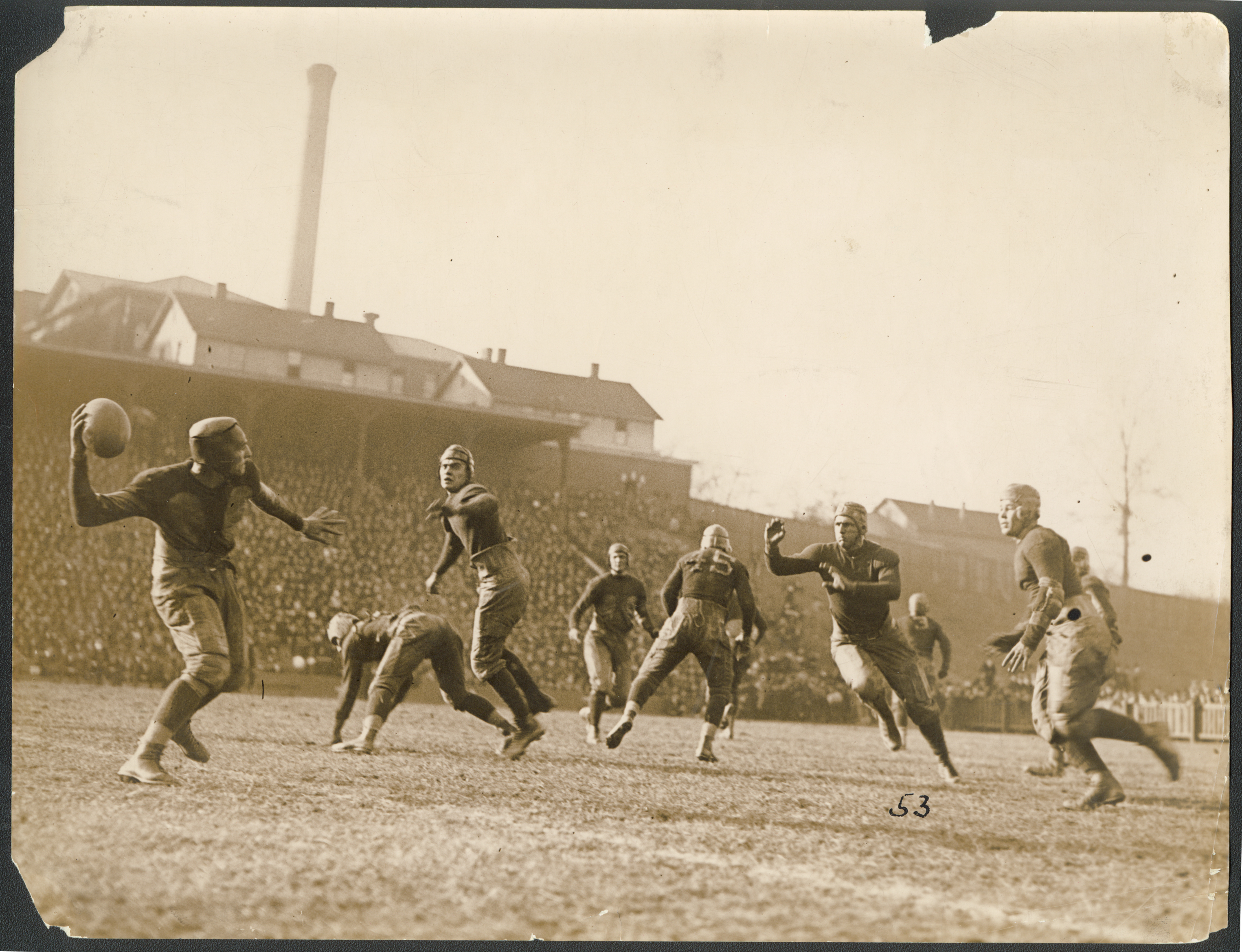The Read-Option Spread: A Butterfly
The spread that is proliferate in college football today is the natural evolution of another style of play. If the spread (particularly the brand of read-option spread football) is a butterfly, then the triple option is the caterpillar. Most Big 12 teams run this style of offense, predicated on RPO’s (run-pass option) and counting the number of defenders in the box.
Before I talk about the correlation between triple option football and the read-option spread, let’s first discuss how most teams defend the triple option. Occasionally, a Power 5 team has to play Army or Georgia Tech. Typically, one player is designated a “QB player,” as in they are responsible for a QB run. This player tends to be the Mike, or middle linebacker. Additionally, there are dive players, responsible only for the fullback dive that is commonplace with Army and Georgia Tech. Finally, there are “pitch players,” who are solely responsible for the running back and a subsequent pitch. These tend to be perimeter players: outside linebackers, safeties, and rover/cornerbacks.
But these coaching staffs find themselves devising new game plans and deviating from base concepts. In an attempt to stay as close to base concepts as possible, many coaches treat triple option like read option. That is to say, because read-option is an evolution of triple option, many coaches choose to simply devolve their base defense, keeping the same base scheme while shifting players around.
Defending the Triple Option
One of the best examples of triple option defense this year, from a team with limited means no less, is Duke. The southern ivy ran a 4-2-5 in 2017, and played both Army and Georgia Tech this past year. In those two games they held Army to 226 rushing yards, and Georgia Tech to 277 rushing yards; those teams average and 362 and 307 rushing yards per game respectively.
The Duke defense chose to play Army in a multiple look; using their base 4-2-5 while occasionally rolling down into a 3-4 with OLB’s playing down at defensive line depth, the free CB playing where the weak-side OLB would normally, and the two safeties rolling down to 6-7 yard depth in between the two ILB’s. You can see this look below; that free CB is the pitch player, and (with the blitz Duke chose to use this play) the Mike is the QB player.

But Duke chose to remain in their base 4-2-5 as much as possible, typically when Army stayed in anything non-heavy, i.e. their base wishbone, wing-t and flexbone. Most formations that involve less than 2 TEs were met with a 4-down look from Duke, which seemed to pay the Devils dividends. You can see the division of tasks in the following play.

Calling the strength to the field (i.e. Sam is on the bottom of your screen) you can see that Mike is playing dive-to-QB, Will is playing QB-to-pitch, and the Safety is a pure pitch player, as he would be in a non-option system. Safeties are perimeter players and alley players, meaning that their responsibility is to run the alley on pitches and outside runs, so its only natural that their responsibility remains in the alley. That OLB is normally an inside-out player, so working QB-to-pitch is a perfectly natural supposition as well. And finally, as you may have guessed, the MLB’s normal responsibility, the A-gap, translates perfectly to a dive-to-QB player. Duke has made their transition from base into an option defense brilliantly simple. Each player has a responsibility that remains almost identical to their responsibilities when playing a non-option ACC opponent.
This is a scheme that works well, unsurprisingly; as noted earlier, the Knights were held to 226 yards rushing, well under the 362 yards they were averaging on the ground in 2017. Army was able to find more success with 7 down linemen and wing players. Duke may be an ACC opponent, but like Army, they struggle to recruit large, super athletic players. However, Duke was definitively faster and more disciplined than most opponents Army tended to face.
Translating to the Big 12
Nowhere is the use of option/spread concepts more prevalent than the Big 12. The conference is typically under fire for being a wild west shootout, but critics tend not to be curious as to why. Teams like OU, TCU and Oklahoma State have nearly perfected what the folks at Football Study Hall have been calling the “Smashmouth Spread”
[T]he main school of offense I’ve used it for is the Chad Morris, Art Briles, or Mike Gundy systems that are indeed looking to smash people up the middle like the spread to run programs and they will do it with two-back lead runs and power… These guys will look to stretch a defense horizontally, because all spread offenses are designed to take easy candy when it’s held out for them, but they really want to push the ball vertically.
The triple option, when it was proliferate, was run best by teams like Nebraska and Oklahoma. It’s amusing that the modern-day triple option (the spread) is run best by former Big 8 teams. And this makes sense–that’s what triple option teams try to do as well. Sure, Army likes their ability to grind out 3 yards when they need to. But at their core, the service academies and Georgia Tech are attempting to wear you out, then break a fullback dive for 40 yards, or a sweep reverse with the wingback for 60. Spread teams are just doing what their fathers before them did: conditioning a defense, then pouncing on their lack of discipline.

If you continue thinking about this, it’s quite logical. Triple option teams were attempting to spread their opponents horizontally, then catch them off guard with a reverse, a dive, or simply beat a pursue player to a spot and turn the corner. The spread teams of today are using a tactic that was not common at the time: the forward pass. Teams from the mid-20th century didn’t think to spread teams vertically because for the most part, they weren’t any good at passing. The idea of passing to stretch a team vertically was nonexistent, but it’s perfectly in line with the conceptual thesis of the triple option. But many teams in the Big 12 stretch vertically, and do it well. A basic example is the dig-post combo that made James Washington so successful.

He did that about 8 million times in 2017.
Big 12 = Big Plays
Solving defense in the Big 12 entirely is a huge endeavor that we can work on later. But the real question that arises when SEC fans or B1G fans watch a B12 game, is “how are they scoring so much?” Well, you have to think of spread offenses in terms of what they’re designed to do: create big plays. SBNation genius Bill Connelly talks about the value of big plays extensively:
Mack Brown initiated a long-term statistical study of … “about 70-some-odd variables” to figure out what truly impacts the college game. The study revealed that big plays (and therefore yards per play) were enormous factors, even bigger than expected. … This study actually led to a change in philosophy for some; perhaps it is worth it to take risks and go for big plays despite the consequences?
When your friends from the SEC ask why teams are scoring so much, it typically comes with two assumptions. The first is that we must not play any defense here in the B12. And the second is that B12 coaches must not understand the value of Saban-like ball control. These assumptions are radically incorrect. The Big 12 aims for big plays, and defenses are geared to “bend not break.”
The SEC and the Big 12 are playing two completely different brands of football, and that was evident in the CFP Semifinal that featured 2OT between UGA and OU. The Bulldogs, with the 6th best defense in FBS last year, allowed less than 300 ypg on average. The Sooners put up 531 yards, the vast majority of which came in regulation. Georgia gave up almost double the yardage they typically do, and looked seriously out of tune in the first half. And, the Sooners won the TOP battle at 32:58.
Oklahoma seriously battered a team that was supposedly going to dominate them defensively. It’s tough to say that either team philosophy “won” in a 2OT game, but the idea that the B12 plays “inferior football” is ridiculous when you consider how foolish Lincoln Riley made the Bulldog defense look.
The Big 12 plays defense; FBS-wide statistics are inflated because most Big 12 teams fail to conform to normal standards of ball control and conservatism. The Big 12 is ahead of the curve offensively, and while the scores can seem jarring to SEC fans used to scores of 21-17, it’s simply a testament to the success of the spread in the Big 12.
Implications
Jim Knowles’ 4-2-5 worked for a team like Duke that played in the ACC and failed to recruit spectacular NFL-ready players. He used speed and discipline in order to gain an edge against teams that Duke did not compete with historically. Knowles was hired away to Oklahoma State last month, and will bring his 4-2-5 to play opposite Gundy’s smashmouth spread offense. Many people were upset with the hire, saying that he was a lateral move at best. Glenn Spencer was good in Stillwater, but sometimes good is not good enough.
I predict within 5 years, Oklahoma State will have a defense tantamount to OU and TCU, if not better. Jim Knowles understands how to do one thing that I believe is crucial to defending the spread: his teams defend the triple option well. The discipline required to limit triple option offenses directly correlates to the discipline required to defend the spread. His 4-2-5 while not proliferate is not uncommon. The Pokes will be able to answer the dig-post combo with the rover, that will cover the middle of the field with better speed.
Knowles comprehends how to defend the triple option, and may have been slightly out of his element in the ACC. Set aside extraneous details, and just look at Knowles’ comprehension of defensive tactics and ability to implement game plans. He’s the coach to defend the spread-option, and he just joined a staff at the forefront of experimental ideas and strategies in college football.




